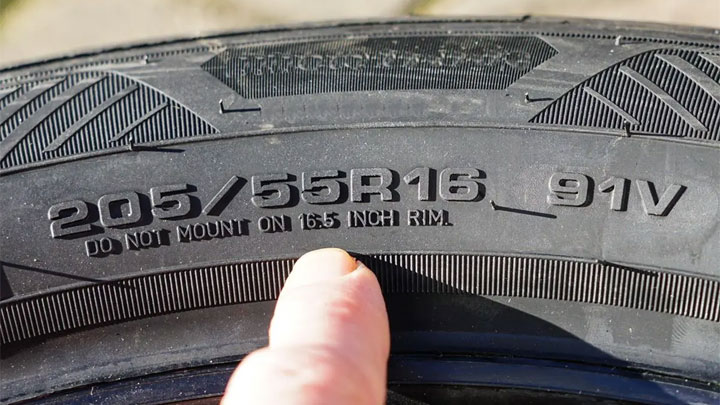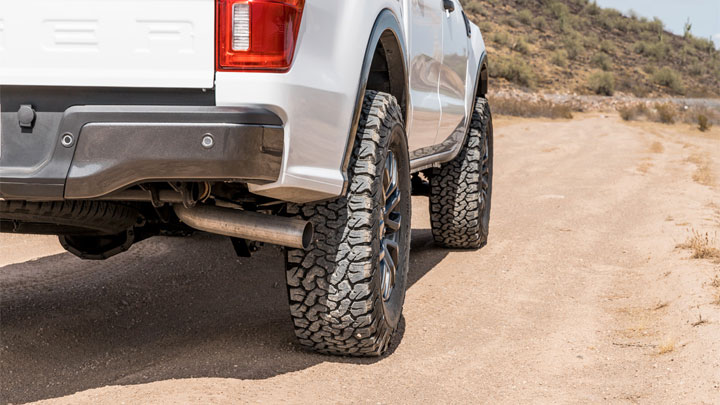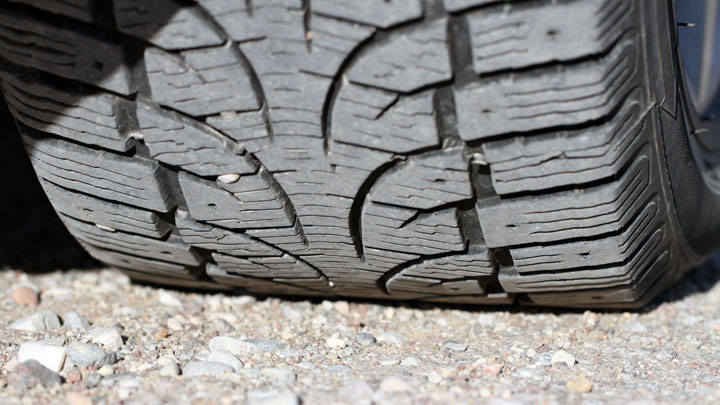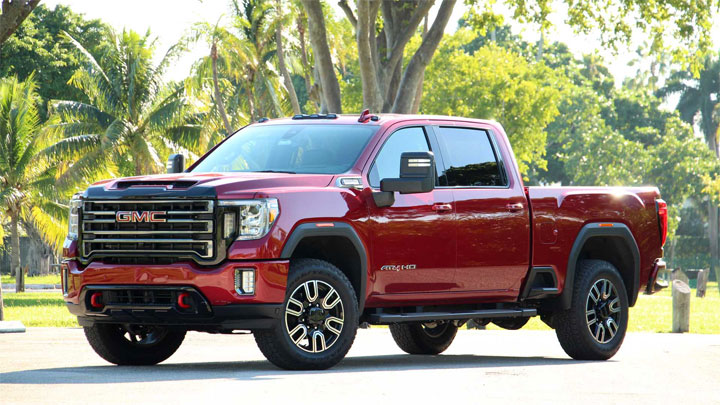How to Read Tire Size (What Sidewall Numbers Really Mean)
Trying to understand the confusing letters, numbers, and codes on your tires? Decoding sidewall numbers including tire size is a lot easier than you may think.
Keep reading to become fluent in the language of sidewalls by learning to interpret tire sizing, safety grades, composition and speed ratings.

Related: 16 Best Tire Brands
Reading Tire Numbers and Sizes
When someone needs to purchase a new tire, they’ll usually go to a tire shop or dealership and have them determine the size of the replacement tire needed.
But you can save a lot of money and get exactly the tires you want by figuring out this information yourself. All it takes is for you to understand the markings on the sides of the tires. And don’t forget the space saver tire in the trunk. Below are 5 proper ways to read the tire size.
See Also: What Do the Numbers on Motor Oil Mean?
Tire Type

Before you worry about the specific size measurements of the tire, you need to first make sure it is the right type of tire. After all, there are tires made specifically for passenger cars, light trucks, and so on.
To find out which type of tire you have, look at the side wall of the tire. You should see a series of numbers which start with one or two letters. If the numbers start with a P, then it means that the tire is for passenger cars. If it starts with an “LT,” the tire is for light trucks.
Temporary spares (commonly referred to as donut spares) have similar marking but are designated with a “T” before the tire size.
See Also: How Long You Can Drive a Spare (Donut, Full-Size, Run-Flat)
Tire Width

Some tires will list the width in millimeters and others will list it in inches. If you see three numbers on the tire’s sidewall coming after the previous letter mentioned, then these numbers represent the total millimeters of the tire’s width.
If you see two numbers after the letter, then it is in inches. The width is measured from one side of the tire straight to the other side.
Keep in mind that while they may provide more traction and look aggressive, wider tires will affect your MPG.
Aspect Ratio

After the tire width, there will be a forward slash followed by an aspect ratio number. The aspect ratio is another way of saying the ratio of the width of the sidewall to the height of it. The ratio number is the percentage of the width which determines the height.
For example, if the aspect ratio is 60, then 60% of the width of the tire will equal the height. The larger the aspect ratio, the taller/higher the tire’s sidewall. When you see sporty cars with what look like skinny tires from the side, these are commonly referred to as “low profile” tires and these have a low aspect ratio.
Related: Are Wheel Spacers Safe? (and Their Pros/Cons)
Tire Construction

The double-digit aspect ratio number is often followed by a letter. This letter represents the type of tire construction. The most common letter found here is “R” which stands for radial. A professional auto mechanic will understand what the letter here means.
Radial is the most common construction technique used for making tires. Some other less common letters you might find here are “B” for belted bias or “D” for diagonal bias.
Related: 5 Causes of Inside Tire Wear
Wheel Diameter

The number listed next is the wheel diameter size. This number will most likely be in inches and it determines the size of the wheel that can fit inside the tire. For example, if you see the number 18 following an “R”, then it means the tire can fit any wheel that is 18 inches in diameter.
See Also: Best Snow Chains (for 16, 17, 18, and 19-inch Tires)
Load Index
The next part of the tire size code is the load index, which is a numerical value that represents the maximum load-carrying capacity of the tire. The load index typically ranges from 75 (equivalent to 853 lbs.) to 125 (equivalent to 3,638 lbs.) but can be lower or higher than that range.
The Load Index chart below can help you find the equivalent weight for a specific index value. Remember, it is crucial to follow the recommended load index for your vehicle to ensure maximum safety and performance.
Load Index Chart
| Load Index | Weight Capacity | Load Index | Weight Capacity | Load Index | Weight Capacity | Load Index | Weight Capacity |
|---|---|---|---|---|---|---|---|
| 70 | 739 lbs | 90 | 1,323 lbs | 110 | 2,337 lbs | 130 | 4,189 lbs |
| 71 | 761 lbs | 91 | 1,356 lbs | 111 | 2,403 lbs | 131 | 4,289 lbs |
| 72 | 783 lbs | 92 | 1,389 lbs | 112 | 2,469 lbs | 132 | 4,409 lbs |
| 73 | 805 lbs | 93 | 1,433 lbs | 113 | 2,535 lbs | 133 | 4,541 lbs |
| 74 | 827 lbs | 94 | 1,477 lbs | 114 | 2,601 lbs | 134 | 4,674 lbs |
| 75 | 852 lbs | 95 | 1,521 lbs | 115 | 2,679 lbs | 135 | 4,806 lbs |
| 76 | 882 lbs | 96 | 1,565 lbs | 116 | 2,756 lbs | 136 | 4,938 lbs |
| 77 | 908 lbs | 97 | 1,609 lbs | 117 | 2,833 lbs | 137 | 5,071 lbs |
| 78 | 937 lbs | 98 | 1,653 lbs | 118 | 2,910 lbs | 138 | 5,203 lbs |
| 79 | 963 lbs | 99 | 1,709 lbs | 119 | 2,998 lbs | 139 | 5,357 lbs |
| 80 | 992 lbs | 100 | 1,764 lbs | 120 | 3,086 lbs | 140 | 5,512 lbs |
| 81 | 1,019 lbs | 101 | 1,819 lbs | 121 | 3,197 lbs | 141 | 5,677 lbs |
| 82 | 1,047 lbs | 102 | 1,874 lbs | 122 | 3,307 lbs | 142 | 5,842 lbs |
| 83 | 1,074 lbs | 103 | 1,929 lbs | 123 | 3,417 lbs | 143 | 6,008 lbs |
| 84 | 1,102 lbs | 104 | 1,984 lbs | 124 | 3,527 lbs | 144 | 6,173 lbs |
| 85 | 1,135 lbs | 105 | 2,039 lbs | 125 | 3,638 lbs | 145 | 6,393 lbs |
| 86 | 1,168 lbs | 106 | 2,094 lbs | 126 | 3,748 lbs | 146 | 6,614 lbs |
| 87 | 1,201 lbs | 107 | 2,149 lbs | 127 | 3,858 lbs | 147 | 6,779 lbs |
| 88 | 1,235 lbs | 108 | 2,205 lbs | 128 | 3,968 lbs | 148 | 6,844 lbs |
| 89 | 1,279 lbs | 109 | 2,271 lbs | 129 | 4,079 lbs | 149 | 7,165 lbs |
Speed Rating
Lastly, the speed rating is represented by a letter and indicates the maximum speed at which the tire can carry a load corresponding to its load index. Speed ratings range from L (75 mph) to Y (186 mph), with Z being used for tires rated above 149 mph.
It’s essential to choose a tire with a speed rating that matches or exceeds the speed capabilities of your vehicle, as specified by the manufacturer. Always consult your vehicle’s owner’s manual or tire manufacturer for recommended tire size, load index, and speed rating information.
Speed Rating Chart
| Speed Rating | Maximum Speed | Speed Rating | Maximum Speed |
|---|---|---|---|
| L | 75 mph | U | 124 mph |
| M | 81 mph | H | 130 mph |
| N | 87 mph | V | 149 mph |
| P | 93 mph | Z | 149+ mph |
| Q | 99 mph | W | 168 mph |
| R | 106 mph | Y | 186 mph |
| S | 112 mph | (Y) | 186+ mph |
| T | 118 mph |
Tire Notation EXAMPLE
Most tires use metric tire notation, which provides you with tire width, aspect ratio, wheel diameter, and more. Using the above information, here’s an example deciphering a tire that’s sized P205/60R17 82S.
- Tire type: The “P” before the tire width indicates this is a tire for passenger cars.
- Tire width: The first number (205) represents the tire width in millimeters. In this case, it’s 205mm or about 8.1 inches.
- Aspect ratio: The next number (60) is the aspect ratio, which is the percentage of the tire’s height to its width. This tells you that the tire’s height is 60% of 205mm.
- Tire construction: The letter “R” indicates radial construction, which is the most common type of tire construction.
- Wheel diameter: The following number (17) represents the wheel diameter in inches. So, this tire fits a 17-inch wheel.
- Load index: The last number (82) is the load index which indicates the tire’s load carrying capacity. This tire has a load index of 1,047 pounds (using the chart in the section above).
- Speed rating: The last letter (S) indicates the code for the tire’s maximum speed rating. In this case, that equals 112 MPH (using the chart in the section above).
Importance of Proper Tire Pressure
Checking your tires’ pressure regularly (at least monthly) is super important. It is best to perform this when they are cold (not immediately after driving), and especially before taking a long trip. The correct tire pressure improves your vehicle’s safety, fuel economy, and braking distance.
To find the recommended tire pressure for your car, refer to the Tire and Loading Information Label typically located on the driver’s side door edge or post or consult your car owner’s manual. Remember, the correct tire pressure is based on your vehicle manufacturer’s recommendation, not the numbers on the tire itself.
Custom Wheel and Tire Size Upgrades
Upgrading your vehicle’s stock wheels and tires can improve its performance and appearance. But it’s essential to choose the right size when upgrading. Here’s what you should know:
- Width: A wider tire can provide more traction, but make sure the new tire width fits your vehicle’s rims and wheel wells without causing any rubbing issues.
- Diameter: Increasing the diameter of your tires may require a larger rim size, as well. This upgrade can improve your vehicle’s stability, but remember that larger tire and wheel combinations add weight and may affect your ride quality.
- Sidewall: A lower aspect ratio results in a shorter tire sidewall, which can improve handling and responsiveness. However, be cautious as this may also lead to a harsher ride quality.
When upgrading your wheels and tires, always consult with a professional, and make sure the custom size is compatible with your vehicle’s specifications.
- Replace the Engine or Replace the Car? (11 Factors to Consider) - Apr 11, 2024
- Plastic Piece Dragging Under Your Car? (What It Is and What To Do) - Mar 21, 2024
- Timing Belt vs Timing Chain (What’s the Difference?) - Feb 27, 2024
